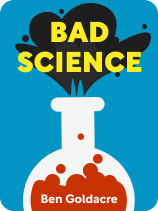

This article is an excerpt from the Shortform book guide to "Bad Science" by Ben Goldacre. Shortform has the world's best summaries and analyses of books you should be reading.
Like this article? Sign up for a free trial here.
What is Bad Science by Ben Goldacre about? What are the main takeaways of the book?
In Bad Science, Ben Goldacre details the strategies researchers, corporations, and journalists use to mislead the public. Goldacre also gives you the tools you need to identify and call out shady science when you see it.
Read below for a brief overview of Bad Science.
Bad Science by Ben Goldacre
Ben Goldacre’s Bad Science is a 2008 popular science title that explains how researchers, healthcare companies, and mainstream media outlets use to mislead the public about medical treatments, often for profit. Goldacre is a medical doctor, a professor at Oxford University, and the author of multiple books on medicine, including Bad Pharma, an in-depth look into corruption in the pharmaceutical industry.
In Bad Science, Ben Goldacre offers a variety of real-world examples to show how the general public has been lied to about medical research, and how those lies have led to tragedy and death. In shedding light on these manipulative tactics, Goldacre endeavors to give his readers the knowledge they need to evaluate medical claims and research for themselves.
Section One: Bad Methods
Scientific trials should be evaluated on their methods, not their results. As we’ll show, by using manipulative methods, it’s possible to engineer whatever result you want. These kinds of manipulations often happen because of the economic pressure to produce and market new treatments. According to Goldacre, most medical research is funded by pharmaceutical companies, who in turn pressure researchers to produce results that help them get their drugs to market.
There are a few main ways researchers manipulate results. These include insufficient experimental controls, inadequate blinding, and inadequate randomization.
Section Two: Bad Claims
Moving on from the level of individual studies, in this section we’ll learn how the alternative and mainstream healthcare industries use a variety of techniques to overstate the effectiveness of their treatments. As Goldacre notes, it’s important to identify and call out these techniques because companies sometimes use them to push ineffective, dangerous treatments to market. When you’re able to evaluate research results yourself, you can make more informed decisions and inform others, too.
The main strategies companies use to make their treatments seem more effective are selective publishing, cherry-picking positive results, and exaggerating based on surrogate outcomes. In this section we’ll explain how these techniques are used to make treatments seem more effective than they are and to conceal their sometimes dangerous side effects. As we describe these techniques, we’ll also give you the tools to spot them.
Marketing Drugs, Marketing Diseases
While Goldacre focuses on the techniques drug companies use to deceptively market their treatments, there’s another part of the process that isn’t addressed here. In addition to marketing drugs, pharmaceutical companies also produce and market diseases.
In order to open up new market niches, companies create new conditions by scaremongering about normal body functions. Generalized symptoms such as tiredness, back and body aches, and stress can be used to sell the public on the need for new supplements and other treatments.
Researchers have described recent disease awareness campaigns about low testosterone levels in older men as examples of this phenomenon. While it’s perfectly natural for testosterone levels to decrease with age, pharmaceutical companies were still able to increase their sales by drumming up a scare.
Section Three: Bad Press
Goldacre covers the various ways mainstream media outlets misrepresent scientific findings to the public. According to Goldacre, errors in science reporting usually happen because publications prioritize profit, which leads them to pressure their reporters to generate the most exciting stories they can as quickly as possible. This pressure leads reporters to choose sensational stories, and leaves them little time to verify the accuracy of their reporting.
Goldacre argues that it’s important for publications to accurately report medical findings because of their unique role in spreading ideas. Misinformation can undermine public health campaigns and lead individuals to make dangerous healthcare decisions.
There are a few major ways journalists tend to misrepresent scientific studies. Specifically, publications fail to evaluate their sources, sensationalize results, and fail to correct their mistakes by publishing retractions and updates. We’ll describe how all these practices can be used to mislead the public, and we’ll give you the tools to identify shoddy science reporting.

———End of Preview———
Like what you just read? Read the rest of the world's best book summary and analysis of Ben Goldacre's "Bad Science" at Shortform.
Here's what you'll find in our full Bad Science summary:
- The strategies researchers, corporations, and journalists use to mislead the public
- The tools you need to identify and call out shady science when you see it
- Why media outlets have an ethical obligation to publish retractions






